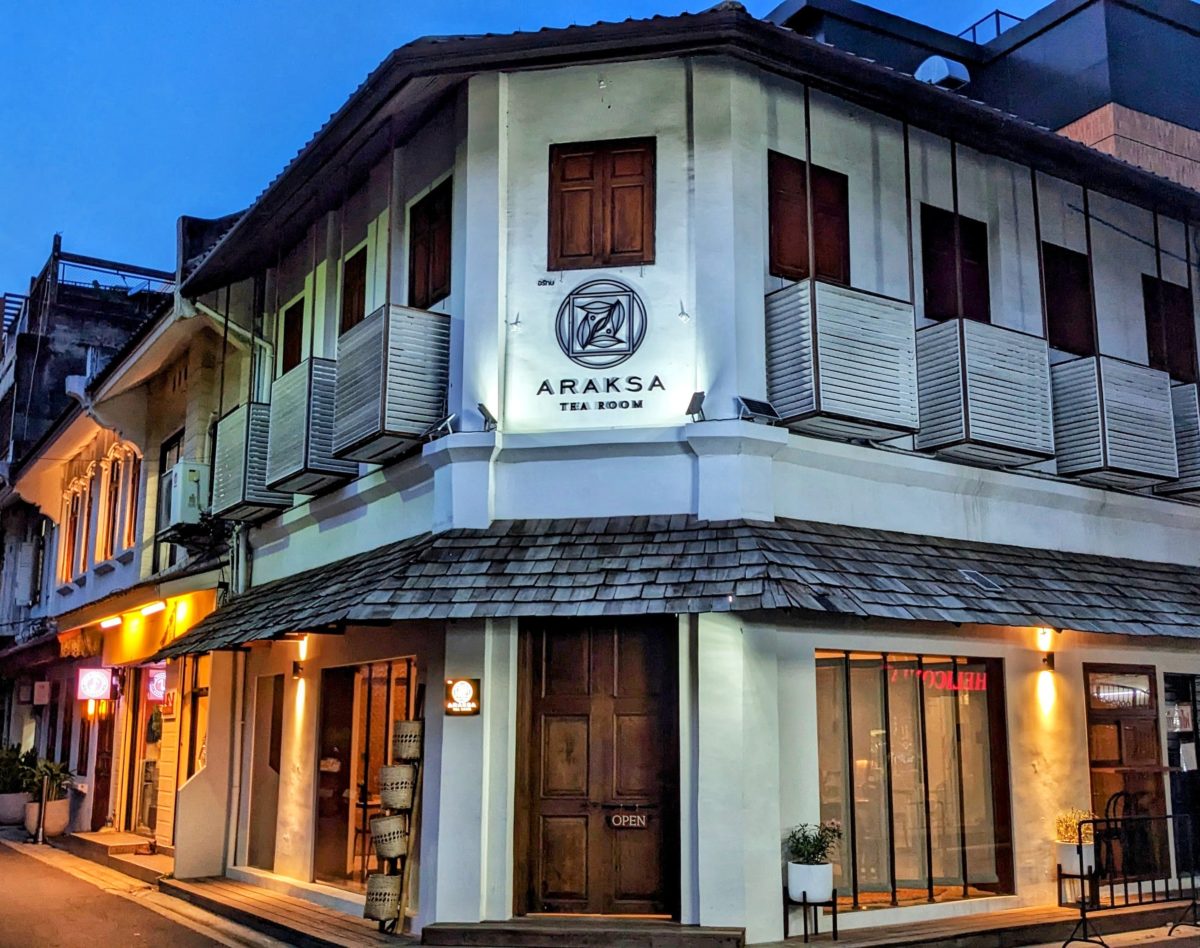
With every delicious sip and satisfying bite, the Araksa Tea Room in Bangkok is revolutionizing Thai tea culture. Their mission is to preserve and promote Thai traditions while elevating how tea and food are produced and consumed in the ‘Land of Smiles.’ The formula is simple: organic award-winning teas, dishes created using locally and sustainably sourced produce, and a bar program that features Thai spirits infused with Araksa teas. Combine all that with an enthusiastic and knowledgeable staff, and you get a unique glimpse into Thailand’s venerated past while being filled with optimism for its bright future.
It Takes a Village
Araksa Tea was founded by the owners of the esteemed Lisu Lodge, a community-based project that works to preserve the heritage of the people of the Northern Hill Tribes of Thailand. When Chananya Phataraprasit and her husband purchased land outside Chiang Mai, they were given an unexpected opportunity.
“We bought the land in 2013 and discovered the abandoned tea garden there. From the beginning, we wanted to focus on organic and sustainable agriculture. I’ve been running the Lisu Lodge for the last 30 years. It’s a sustainable, eco-friendly lodge in Chiang Mai Province. Araksa Tea was founded on the same principles as the lodge. Our tea garden was officially certified Organic in 2018,” says Chananya Phataraprasit, Owner of Araksa Tea.
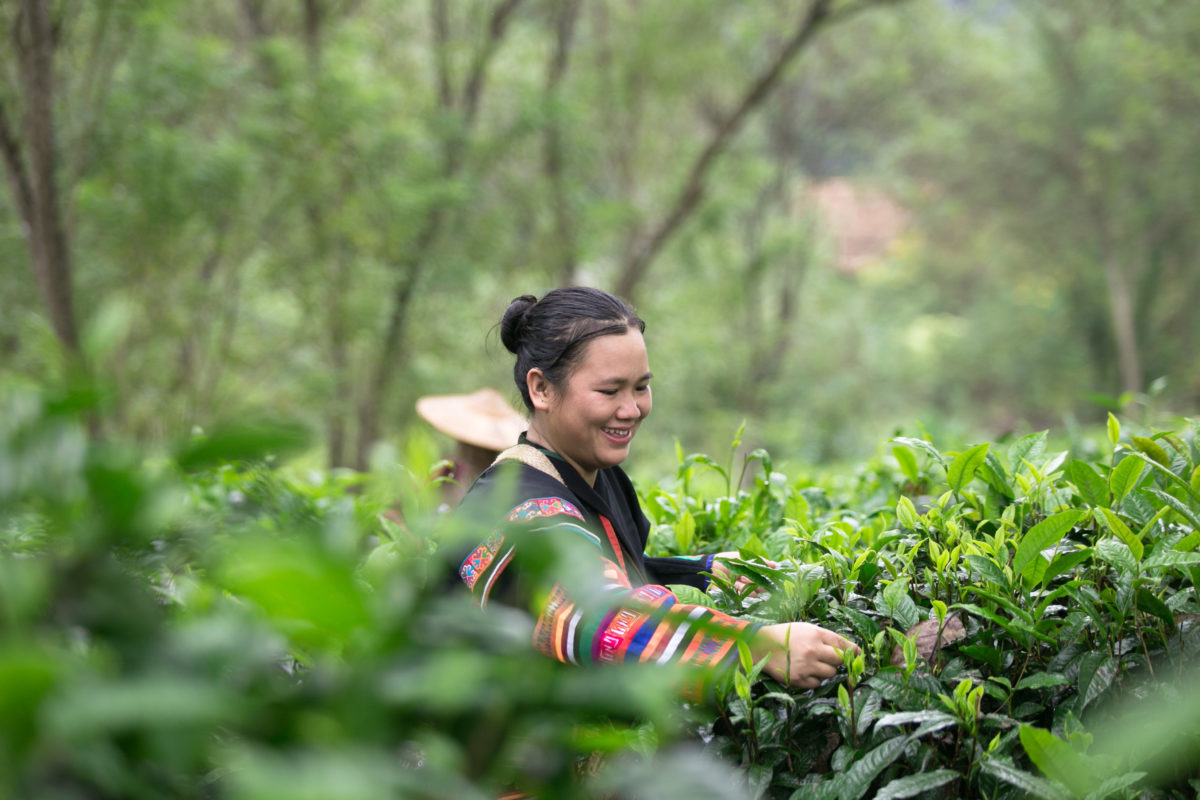
Araksa means ‘to preserve’ in Thai. Everything they do is based upon protecting and promoting the people who care for the land and the tea. Phataraprasit adds, “We’re committed to preserving the culture and life of the local people and communities where the tea is grown. Everything is organic, and all the food we serve is sourced locally, and our Tea Garden is staffed by people from the surrounding villages.” Their employees come from several different tribes, mainly the Lisu, Akka, and Hmong, along with local Thais.
One of Araksa’s popular green teas is called Preserve Green Tea. It’s hand-crafted and roasted over a charcoal fire, a method used in mountain villages for decades.
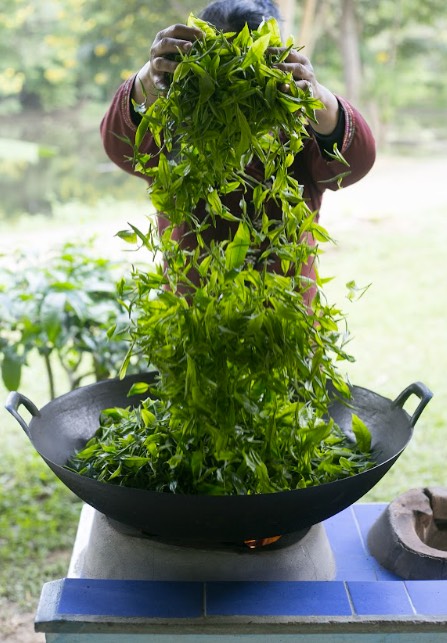
“When we first started, there was a local auntie from one of the hill tribes who made the tea this way, and that’s why we make our Preserve tea this way. To preserve the tradition. We roast the tea in a pan over charcoal. In our Chiang Mai tea garden, when you go on the tea tours, we show the visitors the process of making the Preserve green tea. It’s slightly stronger because it’s roasted in a pan over charcoal. It has a different smell and aroma, with nutty, honey, and woodsy notes. It’s the traditional local Thai way of making tea.” – Ayechan Myint, Araksa Tea Marketing & Sales.
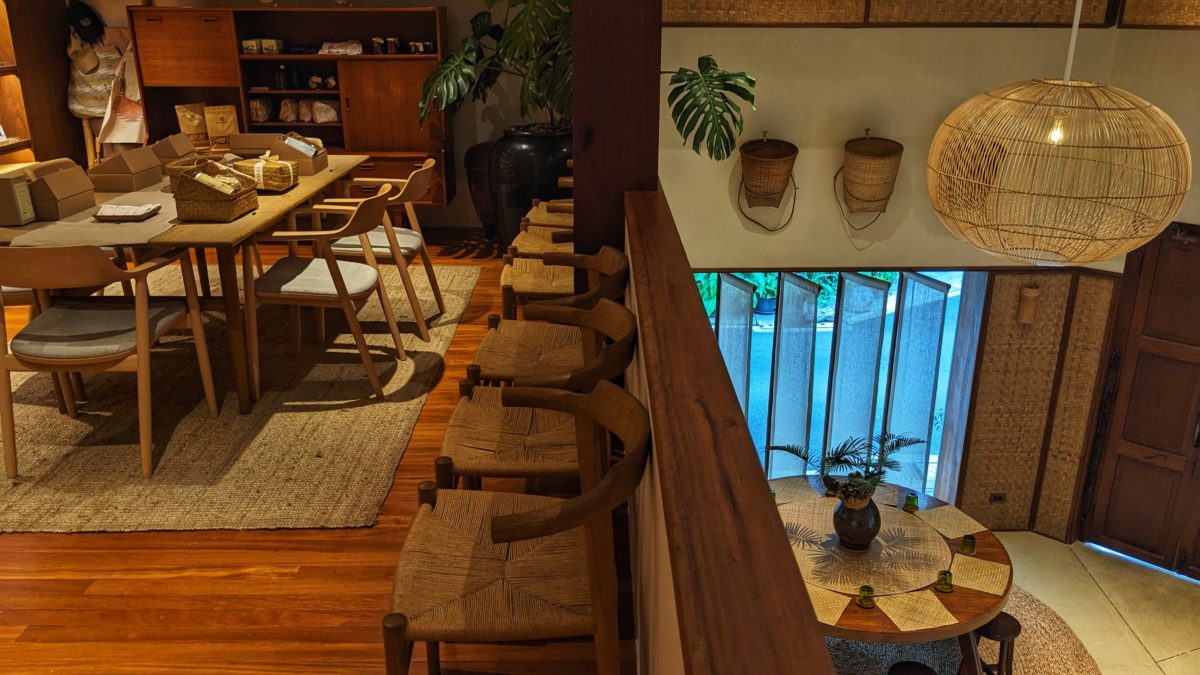
Araksa also works with the surrounding communities to empower them by teaching them new skills and providing more work opportunities. The Tea Garden in Chiang Mai and the Tea Room in Bangkok are decorated with handicrafts made by the local people. Even the wood used to construct and furnish the tea room has been upcycled and sustainably sourced from nearby materials. Their ethos penetrates every aspect of the business.
Elevating Tea Appreciation Through Education
Not many people associate Thailand with award-winning tea. But the team at Araksa is determined to change that. It helps that several of their handcrafted teas have won AVPA medals along with the 2022 Leafies Tea Award. One of the main hurdles they face is that Thai people don’t typically drink loose leaf tea. Instant powdered tea and coffee are still far more common than single-varietal or artisanal tea.
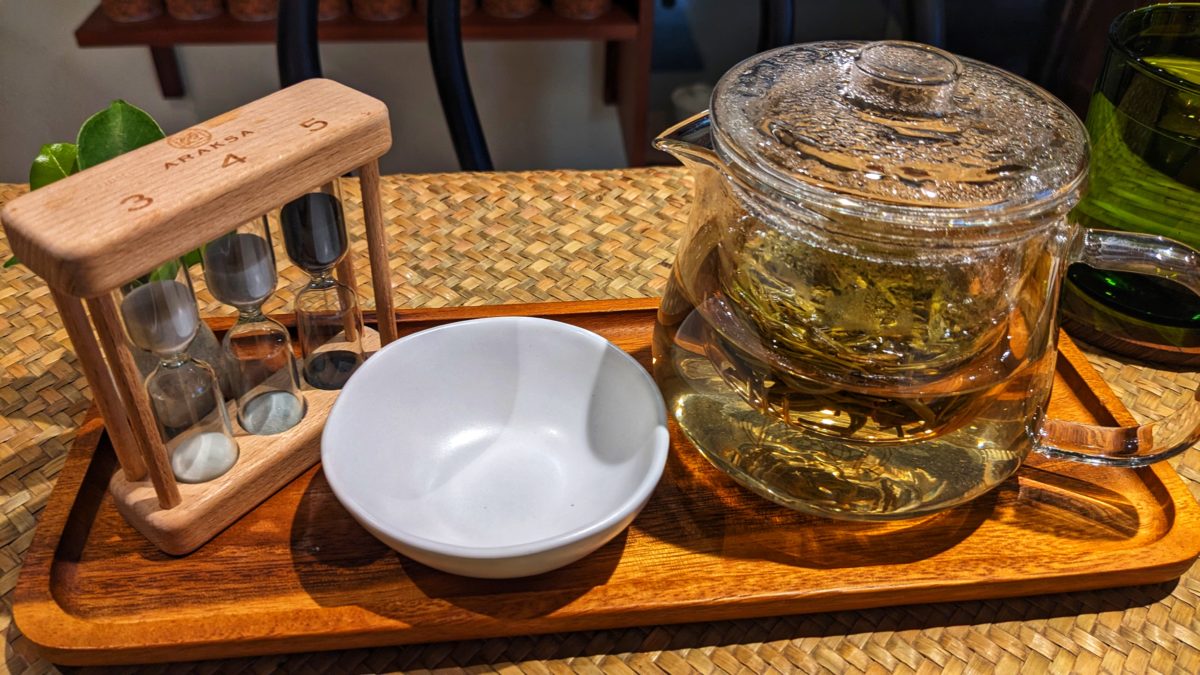
Every time I visit the Araksa Tea Room in Bangkok, I’m impressed by how knowledgeable the staff is. They’re eager and happy to discuss different types of tea with you and provide suggested steeping times for each. Their excellent Tea Sommelier and Master Brewer, Boonyasak Boongoen, has recommended tea pairings with every dish on the menu.
“Educating our staff is very important to me. A new staff member trains with me for two months to learn about the tea, tea service, and pairings. They also spend those two months training with our head chef, so they understand the food, know all the different ingredients, why they’re important, and where they come from,” says Chananya Phataraprasit, Owner of Araksa Tea.
Their impeccable tea service is popular with tourists and foreigners living in Bangkok, but it’s also slowly starting to attract a growing number of Thai fans. Chananya is finally beginning to see a change in Thai tea culture.
“Before, people only wanted to make oolong-style teas, but now there is more diversity in the different teas grown and produced here. Initially, our customers were 80% foreign and 20% local. Now, it’s about 60% foreign and 40% local. We export a lot of our tea abroad, but a growing number of high-end hotels throughout Thailand want to offer high-quality locally grown and produced organic teas. Now the hotels are big customers for us.
When we first opened the tea room in Bangkok, most of our customers were foreign tourists. People who love tea and would search for us or other groups who just happened to be exploring the area and came across us. Now we’re happy to see that it’s about 50/50. With an increasing amount of younger Thais who see us on social media and want to experience the tea for themselves.” – Chananya Phataraprasit, Owner of Araksa Tea
They also offer tea tastings and workshops on tea sensory, pairing, and blending. Representatives from the Araksa team participated in the 2023 SHAPE APAC event, where they met with people from all over the Asia Pacific region to discuss food security and sustainability. Thailand is starting to recognize the importance of collaboration, innovation, and resiliency, with companies like Araksa Tea leading the way.
Embracing the Slow Food Movement
Like many other countries worldwide, Thailand struggles to maintain its culinary traditions despite modern food industrialization. The owners of Araksa Tea understand that tea and food are linked and, therefore, approach their food preparation with the same conscious philosophy as their tea cultivation. The menus at their Tea Garden Cafe in Chiang Mai and Tea Room in Bangkok celebrate traditional cooking methods and use local seasonal ingredients that are organic and sustainably produced.
The Slow Food Movement is all about championing small-scale farmers and handcrafted products. Just as they strive to raise awareness of the true value of tea they also work to build connections between consumers and food producers. True quality takes hard work and time to achieve, and that effort should be rewarded.
While speaking with the Tea Room’s head chef (Toto) Watthikorn Narangkul, I learned about the significance of some of their signature dishes.
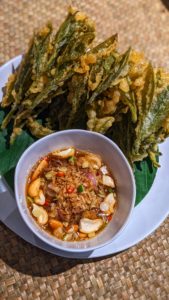
“Yum bai cha tod is crispy deep-fried tea leaves with spicy cashew nuts. The tea leaves come from our own organic tea garden. We make the tea leaves fried like tempura, and you can choose one of three dressings to go with them. One with minced chicken. The chicken is from a biodynamic farm and is the best available chicken in Thailand. We also have a mushroom dressing and an herbal one. Both are for people who are vegetarians. For the herbal dressing, we add roasted coconut flakes and a little bit of lime juice.”- Head chef (Toto) Watthikorn Narangkul, translated by Bee Bunnag.
The tempura-fried tea leaves were perfectly crispy on the outside with a refreshingly grassy finish. They act as an excellent vehicle for the herb dressing, which has a bright citrus zing balanced by the sweet, toasted, nutty flavors of coconut and spicy cashews. With such enticing textures and palate-tingling flavors, I soon emptied the plate.
Their second signature dish is visually stunning, with vibrant yellow and purple hues. The freshness of the ingredients and distinct flavors transport you to a mountain meadow just after the morning mist has cleared.
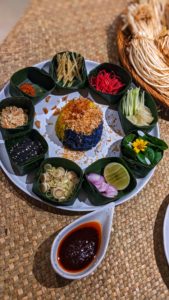
“Khao yum is rice cooked with coconut milk. We have two different types of rice. The blue is cooked with our award-winning butterfly pea flower tea, and the yellow is made from turmeric. The herbal salad is served with housemade chili paste that’s not spicy. It comes with wild ginger flowers, fresh ginger, lemongrass, and pomelo. It also has mango, coconut flakes, fried shallots, sesame seeds, peanuts, and watercress. We also use these two recipes in our tea garden in Chiang Mai.”- Head chef (Toto) Watthikorn Narangkul, translated by Bee Bunnag.
Many of the ingredients on their menu are foraged from the forests of Northern Thailand and are more commonly used by the people of the hill tribes. It’s a rare treat to see such unique flavors in the capital city of Bangkok. I’ve eaten dishes similar to this but have never had one that tasted so pure and perfectly balanced.
In the video: Mixing all of the kaho yum ingredients together ensures that every bite contains all of the different flavors.
My server kindly showed me that the best way to eat kaho yum is by pouring all the individual ingredients on top of the rice and mixing them together. Once blended, each colorful spoonful contained the ultimate combination of sweet, salty, sour, bitter, spicy, and pungent flavors that Thais deem the perfect bite. It tasted bright and fresh, like the pure essence of Thailand.
There was also a hint of caramel and a deep umami richness to the dish that I couldn’t place, so I asked what else was in the dressing. My server quickly brought me a small side of fish sauce that was nothing like any fish sauce I’ve ever had. I lifted the ramekin of amber liquid to my nose and savored the intense and slightly sweet aroma. Not something I normally recommend doing but this wasn’t commercial fish sauce. The sauce was as nuanced as Araksa’s aged Pu-erhs with layers of leather and a sea urchin-like butteriness far more complex than the average fish sauce.
Made in small batches from a women’s collective in Sukothai, it represents a dying art form. Most commercial fish sauce is sourced from fish caught in the Gulf of Thailand and contains sugar, MSG, artificial food coloring, and preservatives. However, with no access to the sea, the people of Northern Thailand traditionally use the small fish that swim in the streams and canals of flooded rice paddies to make their own. These freshwater fish have a sweeter, more subtle flavor. Tragically, due to pollution and industrialization, it’s difficult to find people who still make this unique style of fish sauce in the north.
“Also, the fish sauce we use is local, made in Sukothai. It’s 100% fish sauce. No artificial chemicals or preservatives. Just fish and salt. We don’t use MSG. We want our customers to taste the real natural flavors of the ingredients. We make our own curry pastes; all our meat is grass-fed or free-range. When they come here and taste our food, many of our customers say they can taste the difference in flavor.”- Head chef (Toto) Watthikorn Narangkul, translated by Bee Bunnag.
The same thoughtfulness and creativity apply to their delicious tea-infused desserts and Thai-influenced Afternoon Tea service.
A Tea Journey with Thai Spirits
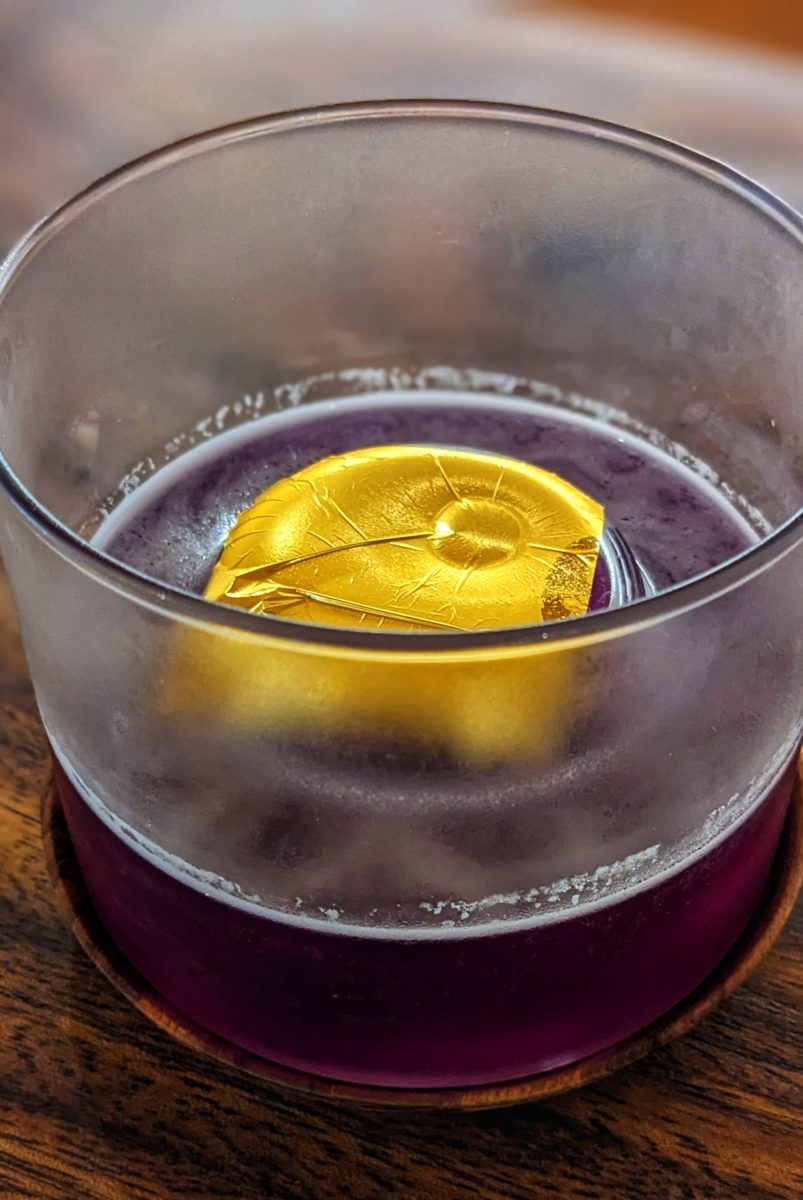
The bar program at the Araksa Tea Room is one of the best in Bangkok. They use spirits distilled in Thailand, organic herbs, botanicals, and teas from their garden in Chiang Mai. After tasting Araksa’s range of teas, their lead mixologist, Jaime McEvoy, was inspired by the tea’s story as it travels south down the river.
“The cocktails represent the tea journey from Chiang Mai to Bangkok. As you pass through different cities, each cocktail uses ingredients from that city. For example, we use green tea in the Chiang Mai cocktail, the green chilies that grow in that area, and Lanna rice vodka. Because Ayutthaya represents the golden temples, we use gold leaf in the cocktail along with Bluefly, our butterfly pea flower, and lemongrass tea with local Kilo Thai vodka and homemade peanut syrup.”- Ayechan Myint, Araksa Tea Marketing & Sales.
Normally not a fan of vodka, I was impressed by the harmony of the Ayutthaya cocktail. The floral notes from their Bluefly tea are enhanced by a hint of citrus and lemongrass and then rounded out by the creaminess of the peanut syrup. A truly superb cocktail that I couldn’t help but finish.
In the video below: Araksa bartender Nunthapong Kittirojjanawong infuses Thai vodka with Araksa’s award-winning Bluefly herbal tea to make the stunning Ayutthaya cocktail.
Several tea-infused mocktails refresh and delight the palate as well. Along with some exceptional cold brew blends and the most delicious iced Thai Tea in Bangkok.
“We don’t only do hot brew teas. We also do iced and cold brew teas because people want to try tea, but the weather is so hot. People who see our Thai tea on the menu assume it’s the same as the Thai tea you can get anywhere. But ours is different. It’s more organic, and we don’t use artificial ingredients or food coloring. It’s all-natural. When we brew it, we always run out. It’s one of our most famous teas. It uses our English breakfast infused with a little bit of vanilla and caramel,” said Ayechan Myint, Araksa Tea Marketing & Sales.
Lead by Example
By striving to build a sustainable business that benefits its local communities, Araksa Tea is at the forefront of a growing trend in Thailand. As the government and more Thai businesses realize that locals and tourists want to support eco-friendly companies, this movement will continue to gain momentum. Thailand is the most visited country in Southeast Asia, so what proves successful there will spread across neighboring countries. Making Araksa Tea a shining beacon of hope for sustainability, quality, and community.
Oh my goodness, this article had my mouth watering. Beautifully written and gorgeous photos. The Thai tea with vanilla and caramel sounds wonderful.
I’m dying to try the Yum bai cha tod. The iced tea sounds beyond. And I was stunned to hear that the cocktails follow the geographical journey of the tea! How cool is that?I’ve never heard of something like that before. Also the staff sounds so well-trained and enthusiastic. This place is officially on my Thai travel agenda. Cannot wait.